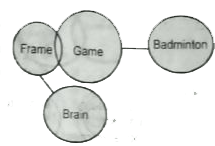Statements - No frame is brain Some frame are game No game is badminton
Conslusions (I) Some game are frame (II) No badminton is brain
If only conclusion I follows
If only conclusion II follows
If either conclusion I or II follows
If neither conclusion I nor II follow.
The correct Answer is:A
Topper's Solved these Questions
Similar Questions
In given questions below are given three statements followed by three conclusions numbered I,II,and III. You have to take the given statements to be true even if they seem to be at variance from the commonly known facts. Read all the conclusions and then decide which of the given conclusions logically follows from the given statements disregarding commonly known facts.
Statements: Some pictures are frames. Some frames are idols. All idols are curtains.
Conclusions: I. Some curtains are pictures.
II. Some curtains are frames.
III. Some idols are frames.
(a) Only I and II follows
(b) Only II and III follows
(c) Only I and III follows
(d) All follows
(e) None of these.
View SolutionStatement/ :
1. All toys are pens.
2. All games are pens.
Conclusion/ :
I.No toy is a game.
II. No pen is a game.
III.Some toys are games.
View Solution
Knowledge Check
Statements: Some chalks are wires.
Some wires are frames.
Conclusions: I Some chalks are frames.
II Some frames are chalks.Aif only conclusion I followsBif only conclusion II followsCif either I or II followsDif neither I nor II follows andStatements:- All basketball are football. Some football are badminton.
Conclusions :- I. Some football are basketball . II. All badminton are football.A(a) if only Conclusion I followsB(b) if only Conclusion II followsC(c) if both Conclusions l and II followD(d) if none of the conclusion followsTwo Statements are given. Followed by two conclusions numbered I and II Assuming the statements to be true, even if they seem to be at variance with known facts. Deicde which of the conslusions logically follow(s) from the statements.
Statements:
1. Some chairs are stoots.
2. All the frames are stoots.
Conclusions:
I. Some stoots are frames.
II. Some stoots are chairs.AOnly conclusions I followsBNeither conclusion I nor II follow.CBoth the conclusions I and II followDOnly conclusions II follows
I have no liking for this kinds of games.
View SolutionStatement - I : Charge is invariant.
Statement -II : Charge does not depends on speed or frame of reference.
View SolutionRead the given statements and conclusions carefully. Assuming that the information given in the statements is true, even if it appears to be at variance with commonly known facts, decide which of the given conclusions logically follow(s) from the statements,
Statements:
1. All toys are pens.
2. All games are pens.
Conclusions:
I. No toy is a game.
II. No pen is a game.
III. Some toys are games.
View SolutionRead the given statements and conclusions carefully. Assuming that the information given in the statements is true, even if it appears to be at variance with commonly known facts, decide which of the given conclusions logically follow() from the statements.
Statements: 1. Few boys play hockey.
2. Few girls don't play badminton.
3. Everyone plays either hockey or badminton
Conclusions:
I. Boys don't play badminton.
II. Few girls play hockey.
III. No one plays both hockey and badminton.
View SolutionIn the question two statements are given, followed by two conclusions, I and II. You have to consider the statements to be true even if it seems to be at variance from commonly known facts. You have to decide which of the given conclusions, if any, follows from the given statements.
Statement I: Some games are sports
Statement II: No exercise are games
Conclusion I: All sports are exercise
Conclusion II: Some exercise are sports
View Solution
